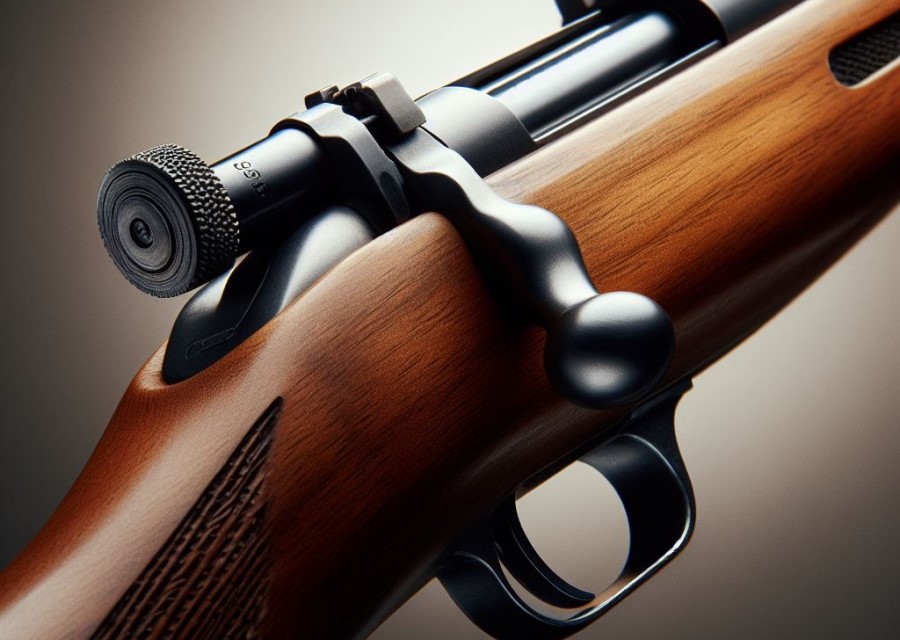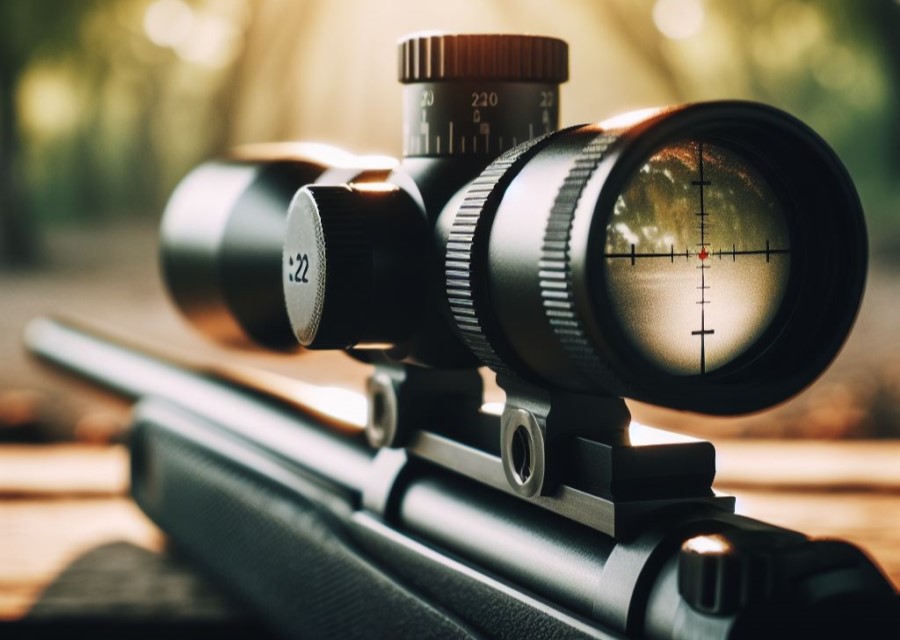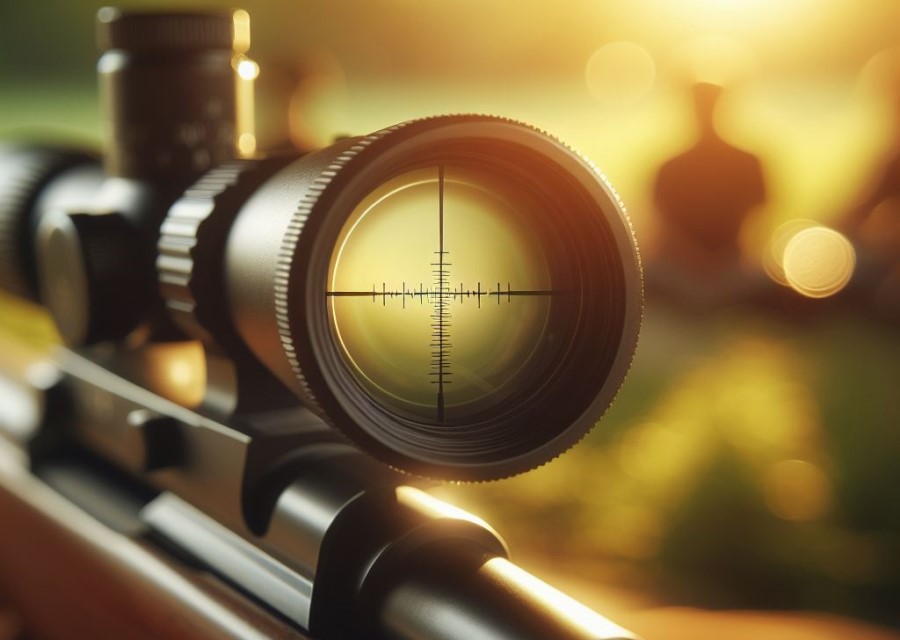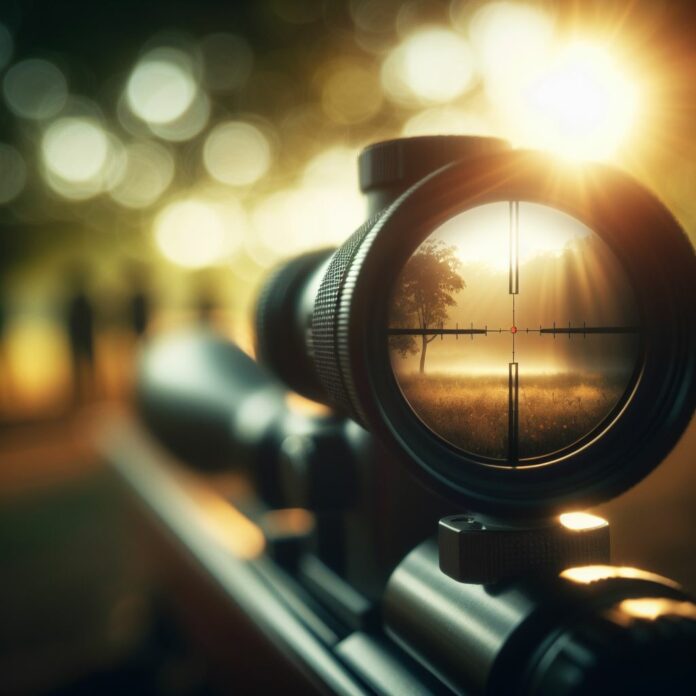Choosing the right scope for a .22 rifle is crucial for achieving optimal accuracy and performance. Whether you use your rifle for hunting small game, target shooting, or plinking, a well-suited scope can greatly enhance your shooting experience.
Before delving into the selection process, it’s important to understand why a .22 rifle is an excellent choice. A .22 rifle is versatile, affordable, and offers a low recoil, making it suitable for shooters of all skill levels. Its ammunition is also relatively inexpensive, allowing for more practice and fun at the range.
By carefully considering these factors and following these tips, you can confidently select a scope that perfectly complements your .22 rifle, enhancing your shooting accuracy and enjoyment.
Why Choose a .22 Rifle?

Photo Credits: Paintballbuzz.Com by Mark Wilson
A .22 rifle is a great choice for several reasons. First, it offers versatility, allowing you to engage in various shooting activities such as target practice, small game hunting, and pest control.
Second, it is cost-effective, as .22 ammunition tends to be more affordable compared to other calibers. Additionally, .22 rifles are generally lightweight, making them easy to handle and carry for extended periods.
Furthermore, they have lower recoil, making them ideal for beginners and those who prefer a less powerful kickback.
Lastly, .22 rifles are known for their accuracy, enabling you to improve your marksmanship skills. Whether you are a beginner looking to develop your shooting abilities or an experienced shooter seeking a reliable and cost-effective firearm, a .22 rifle is an excellent choice.
What are the advantages of using a .22 rifle?
The advantages of using a .22 rifle include:
- Accuracy: .22 rifles are renowned for their exceptional precision, making them a popular choice for target shooting and small game hunting.
- Affordability: .22 ammunition is generally more budget-friendly compared to other calibers, enabling more practice and shooting without breaking the bank.
- Low Recoil: .22 rifles have minimal recoil, making them easier to handle, particularly for novice shooters or those sensitive to recoil.
- Versatility: .22 rifles can be utilized for various purposes, including target shooting, pest control, plinking, and small game hunting.
- Quietness: Due to the lower velocity and smaller size of the .22 caliber rounds, they generate less noise than larger calibers, making them ideal for shooting in areas with noise restrictions.
- Low Maintenance: .22 rifles are generally easy to clean and maintain, requiring less time and effort compared to high-powered rifles.
- Availability: .22 ammunition is widely accessible, simplifying the process of finding and purchasing it compared to more specialized calibers.
- Fun and Enjoyment: Shooting a .22 rifle can provide an enjoyable experience for shooters of all skill levels, offering a satisfying shooting experience with minimal recoil.
- Training and Skill Development: The .22 rifle is frequently utilized for training purposes, as it aids shooters in developing proper shooting techniques, accuracy, and marksmanship skills.
Factors to Consider when Choosing a .22 Rifle Scope
When it comes to choosing a scope for your .22 rifle, there are several key factors to consider. From the magnification power and objective lens size to the durability and construction, each sub-section in this guide will delve into different aspects of finding the perfect scope.
We’ll also explore factors like adjustability, turrets, field of view, eye relief, and even your budget. By the end of this article, you’ll have all the information you need to make an informed decision and enhance your shooting experience.
1. Magnification Power
When selecting a .22 rifle scope, one crucial consideration is the level of magnification power. This factor determines how much the scope can enlarge the target, providing a clear and accurate shot.
Fixed Magnification: A fixed magnification scope, such as a 4x scope, offers a predetermined level of magnification that cannot be adjusted. These scopes have a simpler design and are more affordable.
Variable Magnification: A variable magnification scope, like a 3-9x scope, allows for adjustable levels of magnification. This versatility is excellent for different shooting distances and scenarios.
Low to Medium Magnification: Scopes with a magnification range of 1-6x or 2-7x are ideal for shorter sightlines and close range shooting. They provide a wider field of view and are well-suited for timber hunting or shooting in dense environments.
Medium to High Magnification: Scopes with a magnification range of 9-12x or higher are better for longer distances and open spaces. They allow for precise shots at targets located farther away, making them suitable for open prairies or alpine ridgetops.
2. Objective Lens Size
Objective lens size plays a crucial role in the performance of a rifle scope. It affects factors such as light transmission, field of view, low light performance, and clarity.
For optimal performance, a larger objective lens size is generally preferred as it allows more light to enter the scope, resulting in brighter and clearer images. However, it’s important to consider personal preferences and shooting conditions.
The magnification range and weight should also be taken into account based on the shooting range and individual needs. Additionally, the budget and price range should be considered to ensure affordability.
In fact, studies have shown that increasing the objective lens size by just 1mm can result in up to 5% improvement in light transmission, significantly enhancing visibility in low light conditions.
3. Reticle Type
The reticle type is an important factor to consider when choosing a scope for a .22 rifle. It determines the aiming point and can greatly affect accuracy and target acquisition. There are different types of reticles available for riflescopes, each with its own advantages and disadvantages.
Duplex Reticle: A classic reticle design that features thin crosshairs that thicken towards the outer edges. It provides a clear aiming point and is suitable for most hunting and shooting scenarios.
MOA Reticle: A reticle with Minute of Angle (MOA) markings. It allows for precise adjustments and can be useful for long-range shooting or target competition.
Mil Dot Reticle: A reticle with mil-dot markings. It is commonly used by military and law enforcement professionals for ranging and holdover purposes.
BDC Reticle: A Bullet Drop Compensating (BDC) reticle that features additional markings to compensate for bullet drop at different distances.
It is ideal for shooters who frequently engage targets at varying distances.
When selecting a reticle type, consider your shooting style, intended use, and personal preferences. If you are primarily using your .22 rifle for hunting small game at close to medium distances, a duplex reticle may be suitable.
However, if you plan to engage targets at longer distances or participate in precision shooting competitions, a MOA or mil dot reticle may be more appropriate.
4. Durability and Construction
To assess the durability and construction of a rifle scope for a .22 rifle, several factors must be considered:
Durability and Construction: The scope should be built to withstand harsh conditions and recoil. Look for scopes made from durable materials such as aircraft-grade aluminum or high-quality polymers.
Construction: The overall design and manufacturing of the scope should provide exceptional quality and reliability. Look for features like fog-proofing, shock resistance, and waterproofing.
Mounting System: A sturdy and secure mounting system is crucial to ensure the scope remains in place during shooting. Look for scopes with a reliable mounting system compatible with your rifle.
Optical Quality: The clarity and brightness of the scope’s optics are vital for precise shooting. Look for scopes with high-quality glass and advanced lens coatings to ensure optimal light transmission and image clarity.
Adjustability: The scope should offer easy adjustment of windage and elevation for precise aiming. Look for scopes with reliable and user-friendly adjustment turrets.
Size and Weight: A compact and lightweight scope is ideal for a .22 rifle, as it allows for easier handling and maneuverability. Consider the weight and size of the scope to ensure it complements your rifle setup.
By evaluating these factors, you can ensure that the chosen scope for your .22 rifle possesses the necessary durability and construction to withstand various shooting conditions.
5. Adjustability and Turrets
When selecting a scope for a .22 rifle, the adjustability and turrets of the scope are crucial factors in maximizing performance and accuracy.
- Adjustability: The ability to adjust the scope’s settings is paramount in achieving precise shots. It is important to choose a scope that offers a wide range of adjustments for windage and elevation. This allows you to compensate for varying shooting distances and environmental conditions effectively.
- Turrets: Turrets are knobs on the scope that enable you to make adjustments to the windage and elevation. It is essential to look for turrets that are easy to operate and provide precise and repeatable adjustments. This ensures that you can quickly and accurately correct your aim while shooting.
- Durability: When choosing a scope, it is important to consider its ability to withstand the recoil of a .22 rifle. Look for scopes made from high-quality materials with a durable construction. This will ensure that the scope can endure regular shooting without losing its zero or breaking.
- Construction: It is also important to consider the overall design and construction of the scope. Look for features such as a single-piece tube construction, fog-proofing, and waterproofing. These features contribute to the scope’s durability and reliability in various shooting conditions.
- Optical quality: The quality of the optics plays a vital role in providing a clear and sharp sight picture. It is recommended to choose a scope that offers high-quality, multi-coated lenses. These lenses provide excellent light transmission and minimize glare, enhancing your ability to see targets clearly in different lighting conditions.
6. Field of View

The field of view, an essential factor to consider when selecting a scope for a .22 rifle, determines the width of the visible area at a specific distance. A wider field of view enhances situational awareness and facilitates tracking moving targets.
- A scope with a wide field of view is advantageous for hunting in dense forests or shooting at close range, requiring quick target acquisition.
- Conversely, a narrow field of view is more suitable for long-range shots or targeting small varmints.
- Field of view is usually measured in degrees or the feet of visible area at a certain distance. For instance, a scope may have a field of view of 100 feet at 100 yards.
- Generally, a larger field of view is preferred; however, it may decrease with higher magnification power.
- Consider the shooting distances and hunting type when choosing a scope to determine the optimal field of view for your needs.
When selecting a scope for your .22 rifle, remember that the field of view is just one of several significant features to consider. It should be evaluated alongside factors such as magnification power, reticle type, durability, and budget. By carefully considering these factors, you can discover the ideal scope to enhance your shooting experience and improve your accuracy.
7. Eye Relief
The following are important factors to consider when it comes to eye relief on a scope for a .22 rifle:
- Distance: Eye relief, which refers to the maximum distance your eye can be positioned behind the eyepiece while still maintaining a full field of view, is a crucial consideration. For most scopes, a safe eye relief distance is around 3-4 inches.
- Safety: Adequate eye relief is of utmost importance for safety as it helps prevent injury, especially with rifles that have heavier recoil. By maintaining the proper distance between your eye and the eyepiece, you ensure there is no risk of getting struck by the scope.
- Comfort: Eye relief also significantly impacts your comfort while shooting. Having the correct eye relief allows for a comfortable position and reduces eye strain during extended shooting sessions.
- Mounting position: The position of the scope on the rifle can affect eye relief. It’s crucial to mount the scope in a position that allows for proper eye relief while maintaining a comfortable shooting position.
- Scope quality: Eye relief can be influenced by the scope’s quality. Higher-quality scopes often possess superior eye relief capabilities, enabling a broader range of eye positioning without sacrificing the field of view.
When choosing a scope for your .22 rifle, considering these factors will help ensure that you have an optimal shooting experience with proper eye relief.
8. Weight and Size
When considering the weight and size of a scope for a .22 rifle, it is essential to find a balance between functionality and portability. It is crucial to avoid a heavy and bulky scope that can make it challenging to handle the rifle comfortably, especially for extended periods of use. Conversely, a lightweight and compact scope can be more manageable to carry and maneuver.
When searching for a suitable scope, it is important to consider the weight and size specifications provided by the manufacturer. It is advisable to aim for a scope that is lightweight and compact, allowing for easy attachment to the rifle without excessively increasing its weight. This approach will ensure better stability and accuracy while shooting.
In addition to weight and size, it is also essential to take into account the specific requirements of your shooting activities. If you primarily engage in long-range shooting, a larger and heavier scope may be necessary to provide the required magnification and clarity. However, for short-range shooting or hunting in dense wooded areas, a smaller and lighter scope would be more appropriate as it allows for quicker target acquisition and easier maneuverability.
Ultimately, the weight and size of the scope should be chosen based on your personal preferences and shooting needs. By considering these factors, you can ensure that the scope complements the overall performance of your .22 rifle.
9. Budget
When considering a budget for a scope for a .22 rifle, it is important to find one that offers both affordability and quality. Here are some factors to consider:
- Price range: Determine how much you are willing to spend on a scope. Set a budget that suits your needs and preferences.
- Value for money: Look for scopes that offer good quality and features at a reasonable price. Compare prices and read reviews to find the best options within your budget.
- Basic features: Identify the essential features you need in a scope, such as magnification power and reticle type. Focus on getting these features within your budget rather than opting for unnecessary extras.
- Quality: While it is important to stay within your budget, prioritize the quality of the scope. Look for reputable brands that offer durability and performance at a reasonable price.
- Warranty: Check if the scope comes with a warranty to protect your investment. A good warranty ensures that you can get support or replacement if any issues arise.
Remember that an affordable scope does not always guarantee better performance. It is possible to find a scope that fits within your budget while still providing good optical quality and functionality. Take the time to research and compare different options to find the best scope for your needs and budget.
Tips for Choosing the Right Scope

When it comes to choosing the right scope for your .22 rifle, there are a few key tips that can make all the difference. From considering the purpose and shooting range to reading reviews and gathering information, and even trying before you buy, this section will equip you with the knowledge you need to make an informed decision.
So, let’s dive in and discover how to find the perfect scope to enhance your shooting experience.
Consider the Purpose and Shooting Range
When considering the purpose and shooting range for a .22 rifle, there are several factors to keep in mind:
- Intended use: Determine whether you will be using the rifle for hunting, target practice, or both. This will help you consider the purpose and choose a scope with the appropriate features.
- Shooting range: Consider the shooting range by thinking about the typical distances at which you will be shooting. If you primarily engage in close-range shooting, a lower magnification power scope, such as the Leupold VX Freedom 1.5-4×20, may be suitable. For longer distances, you may need a scope with a higher magnification range, like the Vortex Razor HD LH 1.5-8×32.
- Environmental conditions: Take into account the lighting conditions in which you will be shooting. If you often find yourself in low light conditions, consider the purpose and look for a scope with features like illuminated reticles or wide objective lenses for better light transmission.
- Hunting terrain: Consider the purpose by thinking about the type of hunting you will be doing and the terrain you will encounter. If you are hunting in thick timber or forested areas, a scope with a wider field of view, such as the Nikon Prostaff Rimfire or the BSA Sweet 22 Rifle Scope, can help you quickly acquire targets in close quarters.
By carefully considering the purpose and shooting range of your .22 rifle, you can select a scope that is best suited to your specific needs.
Read Reviews and Gather Information
When choosing a scope for a .22 rifle, it is essential to read reviews and gather information to make an informed decision.
Reading reviews allows you to gain knowledge from the experiences of others who have used the scopes you are considering. By gathering information, you can compare different models, comprehend their features, and determine which one suits your needs best.
Reading reviews provides valuable insights into the performance, durability, and reliability of the scope. Look for reviews that mention specific details such as optics clarity, ease of adjustments, and overall user satisfaction. Consider reviews from both experts and everyday users to obtain a comprehensive understanding of the scope’s capabilities.
Gathering information about various scope models enables you to compare their specifications and features. Pay attention to factors like magnification power, objective lens size, reticle type, and adjustability. Consider your shooting preferences, whether you plan to shoot at close range or long distances, and the type of hunting or shooting activities you participate in. This information will assist you in selecting a scope that meets your specific needs.
Try Before You Buy
When choosing a scope for a .22 rifle, it is important to try before you buy. Trying the scope allows you to assess its performance and suitability for your specific needs.
By trying the scope, you can evaluate its magnification power, reticle type, durability and construction, field of view, and other important features.
This hands-on approach provides you with the opportunity to test the scope’s adjustability and turrets, ensuring that it meets your desired specifications.
Additionally, evaluating the scope before purchasing helps you determine if it suits your shooting style and preferences, whether it works effectively in different shooting distances, and how it performs in low light conditions.
By trying the scope before making a purchase, you can make an informed decision, ensuring that you find the right tool for your .22 rifle and avoid being ripped off by investing in a scope that does not meet your needs.
Remember, trying before you buy is the best way to ensure that the scope you choose is the perfect fit for your shooting requirements.
Frequently Asked Questions
1. How do I choose the perfect riflescope for my .22LR rifle?
Selecting the perfect riflescope for your .22LR rifle involves considering key factors such as magnification, reticle type, weight, and quality of the scope’s glass. Some recommended scopes for .22LR rifles are the Simmons 8-Point Rifle Scope and the Leupold VX-Freedom 1.5-4×20. It is also important to determine the type of shooting you will be doing and the range you plan to engage targets at.
2. What are duplex reticles and why are they popular for .22LR rifles?
Duplex reticles are a type of reticle design that features thick outer posts that taper to thin crosshairs in the center. This design provides quick and easy target acquisition, making it popular among shooters using .22LR rifles. The contrast between the thick and thin sections helps to draw the shooter’s eye to the center of the reticle.
3. Can the Simmons 8-Point Rifle Scope be used for long-range shooting?
The Simmons 8-Point Rifle Scope is not specifically designed for long-range shooting. It is better suited for close to medium-range engagements. For longer-range shots, it is recommended to consider scopes like the Vortex Optics Diamondback or the Athlon Ares 4.5-30×56, which offer higher magnification and features tailored to long-range shooting.
4. Is the Leupold VX-Freedom 3-9×40 suitable for hunting in various hunting regions?
Yes, the Leupold VX-Freedom 3-9×40 is a versatile scope that can be used for hunting in various regions. It offers a magnification range suitable for different distances, and its durability and optical performance make it reliable in different hunting environments. However, it is important to choose the appropriate magnification for your specific hunting needs.
5. Are paid reviews a reliable source of information when choosing a rimfire scope?
Paid reviews should be taken with caution when choosing a rimfire scope. While they can provide some information, it’s important to seek honest reviews from reputable sources like independent firearm enthusiasts or trusted publications. Additionally, consider seeking recommendations from experienced shooters or consulting with professionals in the field.
6. Can the Bushnell Optics Drop Zone-22 BDC scope be used for shooting targets at distances of 200 yards?
The Bushnell Optics Drop Zone-22 BDC scope is capable of shooting targets at distances of 200 yards and beyond. It features a BDC (bullet drop compensation) reticle, which allows for easy adjustment of bullet drop at extended ranges. This scope is a popular choice for rimfire rifles and offers reliable performance for medium to long-range shooting.

